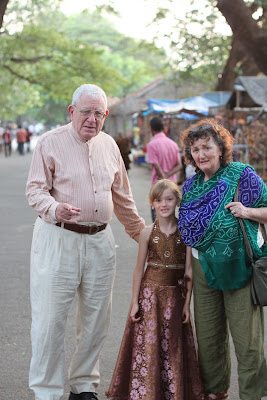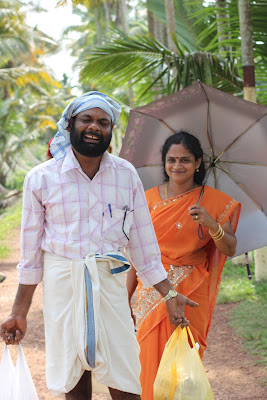 You must laugh at one point in the tuk tuk negotiation to show you are not aggressive and really don't care that much whether or not you get this particular tuk tuk. You can move onto another, really! We actually really liked our tuk tuk driver/guide, in the end.
You must laugh at one point in the tuk tuk negotiation to show you are not aggressive and really don't care that much whether or not you get this particular tuk tuk. You can move onto another, really! We actually really liked our tuk tuk driver/guide, in the end. Ken reveals his true underlying stress of all the negotiations and being the travel leader for our band of 7.
Ken reveals his true underlying stress of all the negotiations and being the travel leader for our band of 7.






 Portugese brought these INCREDIBLE trees to India. They provide shade and charm as you walk the streets of Fort Kochin, or, in our case, as you use the tuk tuks as motorized wheelchairs instead of walking.
Portugese brought these INCREDIBLE trees to India. They provide shade and charm as you walk the streets of Fort Kochin, or, in our case, as you use the tuk tuks as motorized wheelchairs instead of walking.



 Ken and I got away for a Ayurvedic massage. Smelled so good! Not deep tissue enough for us but sure was relaxing and nice to have husband/wife time.
Ken and I got away for a Ayurvedic massage. Smelled so good! Not deep tissue enough for us but sure was relaxing and nice to have husband/wife time.
April 5, 2011
Yes, there’s a “Jew Town” in Kochin, India, and we’re convinced we were the only Jews there. But, they certainly do haggle, hassle, and bargain you as well as the best Jews in Israel, even if they were non-Jewish Indian. Actually, Sarah in the picture above may have been Jewish, but her staff was Indian. Turns out there are actually 5 Jewish families supposedly left in Kochin. But, there used to be over 2000 Jews in Kochin.
Here’s the story, after the burning of the second temple in Jerusalem, the Jews fled Israel and were scattered all over the world. Some ended landed in Northern India in 40 AD. They lived there for centuries until 1490s when the Spanish Inquisition happened when the Portugese and Moors hunted down the Jews. The Jews fled Northern India and landed in Kochin, depicted by a painting of a Jewish Prince carrying his wife through the sea shallows to the local Kochin Raj to ask for his protection. The Kochin Raj agreed and the Jews built their new Synagogue right next to the Raj’s palace, for extra protection. The Jews were happy there for years, until 1949 when Israel was born and they all moved back to Israel.
Jew Town remains alive. Mostly as a draw for tourists to buy lots of knick knacks. The synagogue supposedly lives on, with active Friday night services, but only when there’s a quorum of 10 or more Jews present. Unfortunately, given that only 5 families live in Kochin, and even with the help of an extra 10 Jewish families in the state of Kerala, they often are not able to hold services in the temple, but, rather, hold them in a local home.
We weren’t allowed to take photos in the temple, so let me describe the temple for you. The temple was at the end of Jew Town road, with a bit of an open field on one side of the street, blocked by a gate with Jewish stars and menorahs on it. The temple had a small museum with paintings that adeptly told the story I repeated above of how the Jews got to Kochin. Our kids were fascinated when Ken digested it for them. The temple was pretty simple, white, with a small sort of bell tower at the top. And, the ceiling as covered in glass chandeliers, and a pulpit in the middle, as is typical of Sephardic Jews. The Torah was in the back, with the Ten Commandments in Hebrew on either side.
A couple Indians overheard Ken asking Griffin to read the Hebrew, with Harvey chiming in corrections. The Indians eagerly asked Ken if he could read the Hebrew to them, and he did read the prayer to them. They were really impressed he could read Hebrew, as if they saw it as an ancient, lost language with exotic appeal. Ken was glowing when he spoke with them, acknowledging afterwards what a relief it was to not have to hide that he was Jewish, since he’s been hiding his religion for months now in Malaysia. And, he’s been asked often in Malaysia what religion he is since Malaysians love to ask everyone that question and he’s a puzzle – expat, Western, shaved head, long goatee, not unlike some Muslim Malaysian men. In fact, some Muslim Malaysians have ironically asked him if he’s Muslim. And, he had to say “No, I’m Christian.” Needless to say, that’s unsettling for him to have to put up such a ruse, and it was equally a relief to be open about who he is. And, the kids were curious about why they could be open about being Jewish here in India but not in Malaysia. We had more than a mere tourist visit to a nearly abandoned synagogue in India.
The first few photos above show our negotiation with the tuk tuk drivers before our day out. We had negotiated a day rate to get two tuk tuks to drive us around Kochin, slippery negotiation at that, without any real commitment to a rate til the end of the day. So, we had the tuk tuks drive us literally a couple blocks (a relief given the heat!) to the Jewish cemetery, still preserved, which was appreciated by Ken that the Indian government would preserve it.
We ended our last day in Kochin at the Brunton Boatyard with a gorgeous view of the harbor, expansive grassy place to chase the kids in a game of Monster, and Harvey was happy since he could finally put (filtered) ice in his Jack Daniels. Onto Munnar Mountains tomorrow!




































































